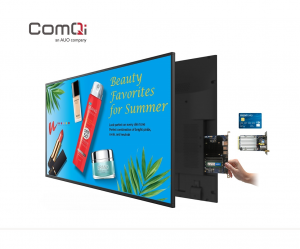ComQi, AUO And Intel Team Up On New Digital Signage Displays
New All-In-One Digital Signage Displays Use Intel’s Smart Display Modules, Reducing Costs Without Adding Hassles Or Restrictions
New York – A new all-in-one digital signage solution from ComQi and its parent company AUO provides all the streamlined and cost-trimming advantages of a smart display, with none of the technical compromises, restrictions or hassles.
The new ComQi solution uses Intel’s Smart Display Module (SDM) architecture to put a media player inside a set of AUO commercial LCD displays, but make the player modules swappable for easy repairs and upgrades. The players quickly dock in and out of a slot in the screens.

ComQi’s SDM solution is launching with a pair of standard and high-demand slot-loaded PC modules, for standard displays, sized at 43 and 55 inches diagonal and video wall displays, sized at 46 and 55 inches diagonal. The configurations can be mixed and matched, as either module fits with either display.
Both players run on the Ubuntu Linux operating system and are fully integrated and ready to run and work with ComQi’s highly-regarded EnGage content management platform for digital signage and interactive retailing.
“More and more so-called smart displays have entered the digital signage marketplace, and while we’ve always liked the streamlined design and cost reductions that come with screens that have built-in media players, we’ve also had our reservations,” says Stuart Armstrong, Group President and Chief Revenue Officer of ComQi.
“First, if there is a problem with the display or the embedded player, the whole display panel may have to come down, and probably go back to a depot for repair. That means the screen could be out for days, which is a non-starter for many customers especially mission-critical applications like food services and mass transport,” he explains. “However, with AUO’s SDM displays, we minimize downtown by easily swapping out the SDM card without having to dismount the screens.”
“Second, there’s very little continuity across the different manufacturers that have smart displays. To support smart displays from three companies, software providers need to develop and maintain three new variations of their software to support their customers, and even then, you will not get everything an SDM solution can deliver,” adds Armstrong.
Working with Intel® and AUO, ComQi has instead developed an SDM series that realizes several benefits:
- While most smart displays use computing processors originally intended for smart TVs and portable devices within the consumer market, SDM units are proper commercial-grade PCs that can run multiple operating systems like Linux, Windows or Android;
- The same version of EnGage that runs on PCs runs on the SDM modules;
- Capital costs are trimmed because the SDM modules cost are less than external PC media players;
- If field repairs are needed, or upgrades required, it takes seconds to complete;
- SDM provides the all the streamlined benefit of system on chip smart displays – reducing the cabling to a single power cord, which speeds installations and minimizes field outages.
“One of the key technical benefits of our approach is that end-users who want to use smart displays are not restricted to the power and capabilities of whatever system on chip media processor the screen manufacturer has used in that year’s product line-up,” says Greg Galvin SVP Technology and Solutions, ComQi. “By using SDM modules and AUO displays, customers can use a general-purpose SDM module that will do most jobs very well, and for those screens and tasks that have high-resolution graphic demands, they can use the more powerful version that has an Intel Core i7 inside.”
Intel’s Smart Display Module design is the second-generation of smart players developed by the tech giant. The modules are roughly one-third the size of the units built for Intel’s original Open Pluggable Specification (OPS), which pioneered the concept of smart displays and hot-swappable media players.
There are two versions of Intel® SDM – the Intel® SDM–S is not much larger in footprint than a credit card, and a larger one (Intel® SDM–L). AUO’s 24/7 commercial grade displays support both sizes from one design, and ComQi is using the larger versions for its players.
About ComQi
ComQi, a wholly owned subsidiary of AUO, is a global leader providing cloud-based digital signage & shopper engagement technologies
Through its content management solution – EnGage™, ComQi allows any brick and mortar location to inform & influence customers, using all digital touch-points like in-store media, mobile, video, touch, social media etc. EnGage™ drives traffic, increases sales, engages customer, improves brand loyalty & empowers sales associates.
ComQi is a full-service company as such it ensures the highest level of design, deployment, custom development, content management & on-going support.
For more information, visit https://comqi.com/
About AUO
AU Optronics Corporation (AUO) is a global leader in display technologies, with a comprehensive, diversified portfolio of display products and services. Listed on the New York Stock Exchange and on the Taiwan Stock Exchange, AUO generated $10.05 billion USD in sales revenue in 2018. Headquartered in Hsinchu, Taiwan, AUO has more than 43,000 employees throughout its global operations spreading across Taiwan, Mainland China, Japan, Singapore, South Korea, the United States, and Europe.
For more information, visit www.auo.com
About Intel
Intel (NASDAQ: INTC), a leader in the semiconductor industry, is shaping the data-centric future with computing and communications technology that is the foundation of the world’s innovations. The company’s engineering expertise is helping address the world’s greatest challenges as well as helping secure, power and connect billions of devices and the infrastructure of the smart, connected world – from the cloud to the network to the edge and everything in between.
Find more information about Intel at newsroom.intel.com and intel.com.
